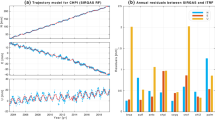Abstract
This paper presents a high level proposal for how a Local Reference Frame (LRF) could be implemented alongside the International Terrestrial Reference Frame (ITRF) as part of a two-frame national geospatial reference system. By accounting for both local and global geodynamic effects using time-dependent transformations, the LRF can minimize the complexity that results when objects that are fixed with respect to the ground have continuously time-varying coordinates in a global frame.
The role of the national geospatial reference system, of which the reference frame is a core component, has changed. Whereas traditionally a national geodetic datum of the highest available precision has been required for accurate surveying and positioning, GNSS-derived positioning now provides easy access to precise global reference frames such as ITRF. However, the exponential growth of spatial data sets has created a need for a geospatial reference system providing coordinates that are “ground-fixed”. That is, the system provides coordinates that can be used to locate and relate physical features, and to align spatial data sets acquired at different times. This requires the definition of a LRF and reference epoch, with clear traceability to a global reference frame such as ITRF.
The ITRF has long been adopted as the most precise means of accessing a LRF using Precise Point Positioning (PPP) and global post-processing services, or for applications where the highest precision is required. However, transformation to the local frame has not always been carried out robustly, whether due to a lack of officially defined transformations or failure of systems to utilize time-dependent transformation parameters. Formal recognition of ITRF within a national spatial referencing system will support the increasingly broad range of users and applications utilizing high precision ITRF coordinates derived from absolute positioning, including rapidly emerging real-time PPP services and geodetic imaging techniques such as Lidar and InSAR.
While some of the implementation details will differ to reflect the local tectonic and legislative environment, the suggested framework could be used by any jurisdiction considering an updated approach to defining the reference frame in its national geospatial reference system.
Access this chapter
Tax calculation will be finalised at checkout
Purchases are for personal use only
Similar content being viewed by others
References
Altamimi Z, Collilieux X, Metivier L (2011) ITRF2008: an improved solution of the international terrestrial reference frame. J Geod 85:457–473
Amos M (2009) New Zealand Vertical Datum 2009. N Z Surveyor 300:5–16
Crook C, Donnelly N (2013) Updating the NZGD2000 deformation model. In: Proceedings of the 125th New Zealand Institute of Surveyors Conference, Dunedin, 29–31 August 2013.http://www.nzisltsurveybook.org.nz/sites/all/files/joint%20proceedings%20nzis%20sircnz_V1.pdf. Accessed 20 Aug 2011
Dawson J, Woods A (2010) ITRF to GDA94 coordinate transformations. J Appl Geod 4:189–199
Drewes H (2009) Reference systems, reference frames, and the geodetic datum – basic considerations. In: Sideris M (ed) Observing our changing earth. Proceedings of the 2007 IAG General Assembly, Perugia, Italy, July 2–13, 2007, International Association of Geodesy Symposia, vol 133, pp 3–9
ICAO (2002) World Geodetic System – 1984 (WGS-84) manual, 2nd edn, Doc 9674, AN/946, International Civil Aviation Organization. http://www.icao.int/NACC/Documents/Meetings/2014/ECARAIM/REF08-Doc9674.pdf. Accessed 4 July 2015
ISO (2007) ISO19111:2007 geographic information – spatial referencing by coordinates. International Organization for Standardization
Johnston G, Morgan L (2010) The status of the national geospatial reference system and its contribution to global geodetic initiatives. In: Proceedings of XXIV FIG World Congress, 11–16 April 2010, Sydney, Australia. http://www.fig.net/pub/fig2010/papers/ts06c%5Cts06c_johnston_morgan_4116.pdf. Accessed 4 July 2015
Land Information New Zealand (2015) NZGD2000 deformation model. http://www.linz.govt.nz/data/geodetic-system/datums-projections-and-heights/geodetic-datums/new-zealand-geodetic-datum-2000. Accessed 4 July 2015
Petit G, Luzum B (eds) (2010) IERS conventions (2010), IERS technical note 36. Verlagdes Bundesamts für Kartographie und Geodäsie, Frankfurt am Main, Germany. http://www.iers.org/IERS/EN/Publications/TechnicalNotes/tn36.html. Accessed 4 July 2015
Stanaway R, Roberts C, Blick G (2014) Realisation of a geodetic datum using a gridded absolute deformation model (ADM). In: Rizos C, Willis P (eds) Earth on the edge: science for a sustainable planet. Proceedings of the IAG General Assembly, Melbourne, Australia, June 28 to July 2, 2011. International Association of Geodesy Symposia, vol 139, pp 259–256
Stanaway R, Roberts C, Rizos C, Donnelly N, Crook C, Haasdyk J (2015) Defining a local reference frame using a plate motion model and deformation model. In: Proceedings of IAG Commisison 1 Symposium 2014: Reference Frames for Applications in Geosciences (REFAG2014), 13–17 October, Kirchberg, Luxembourg
Tregoning P, Burgette R, McClusky SC, Lejeune S, McQueen H, Watson CS (2013) A decade of horizontal deformation from great earthquakes. J Geophys Res 118. doi:10.1002/jgrb.50154
Acknowledgements
This work has been supported by the Cooperative Research Centre for Spatial Information, whose activities are funded by the Australian Commonwealth’s Cooperative Research Centres Programme.
Author information
Authors and Affiliations
Corresponding author
Editor information
Editors and Affiliations
Rights and permissions
Copyright information
© 2015 Springer International Publishing Switzerland
About this paper
Cite this paper
Donnelly, N., Crook, C., Stanaway, R., Roberts, C., Rizos, C., Haasdyk, J. (2015). A Two-Frame National Geospatial Reference System Accounting for Geodynamics. In: van Dam, T. (eds) REFAG 2014. International Association of Geodesy Symposia, vol 146. Springer, Cham. https://doi.org/10.1007/1345_2015_188
Download citation
DOI: https://doi.org/10.1007/1345_2015_188
Publisher Name: Springer, Cham
Print ISBN: 978-3-319-45628-7
Online ISBN: 978-3-319-45629-4
eBook Packages: Earth and Environmental ScienceEarth and Environmental Science (R0)



